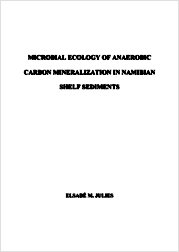Microbial ecology of anaerobic carbon mineralization in Namibian shelf sediments
Julies, Elsabé Mathilda
Univ. Bremen
Monografie
Verlagsversion
Englisch
Julies, Elsabé Mathilda, 2008: Microbial ecology of anaerobic carbon mineralization in Namibian shelf sediments. Univ. Bremen, DOI: 10.23689/fidgeo-186.
 |
Dokument öffnen: |
Carbon, Upwelling, Namibia, shelf, sediments. - This PhD thesis is an essential component of the 'Namibia Gas' (NAMIBGAS) project, which aims to improve the understanding of the rate and fluxes of hydrogen sulfide and methane to the sediment surface and into the water column on the Namibian shelf, which is one of the most productive upwelling systems on Earth. Organic matter degradation in the sediment drives hydrogen sulfide production, the maintenance of anoxia, and methane formation. Therefore, the primary aims of the thesis are to study carbon transformation processes within the sediment, determine the reactivity of organic carbon in the sediment and, investigate the control of microbial community structure and activity by the amount and accessibility of carbon sources. The emphasis is on linking microbial community structure (identity) to their function (activity) to provide new insights into the microbial ecology that controls carbon turnover in these upwelling sediments. By studying the stepwise degradation of organic carbon a complete process overview of organic carbon mineralization could be obtained. Firstly, the diagenetic transformation of dissolved organic carbon (DOC), in particular dissolved carbohydrates, was studied by using both biogeochemical methods and molecular techniques. The bulk sediment composition, pore water chemistry, polysaccharide hydrolysis rates, 35S-sulfate reduction rates, and the abundance of active bacteria involved in the initial and terminal processes of organic carbon degradation within the top 15 cm of the sediment from two sampling stations were determined (Chapter 2). Secondly, the diversity of bacteria from the same ...
Statistik:
ZugriffsstatistikSammlung:
- Geologie [933]

